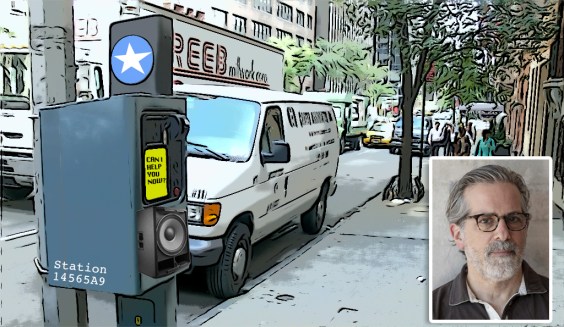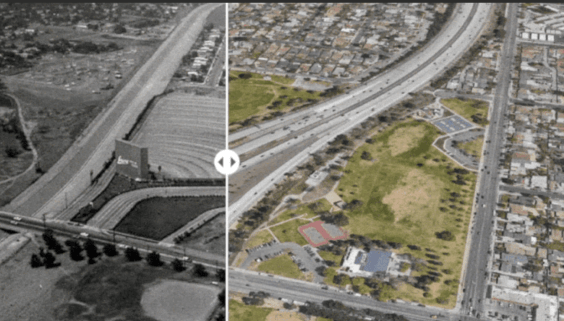
With freeways and wide thoroughfares running through neighborhoods of color, the City of Oakland demonstrates many of the deadly trends discussed in Transportation for America's new Dangerous by Design Report.
Across the country and locally, people of color make up a disproportionately large share of pedestrian deaths. Nationwide, the annual pedestrian fatality rate among African Americans is 2.39 deaths for every 100,000 people. Hispanics suffer a somewhat lower rate (1.97), while rates among Asians (1.45) and whites (1.38) are substantially lower.
As the map above illustrates, all of Oakland's traffic fatalities during the last five years occurred in the flats, an area with a higher proportion of people of color than the relatively affluent hills. Less than three percent of pedestrian fatalities in the 2000s occurred in the hills (the most recent in 2005). You can see data for 2001-2009 on Transportation for America's site.
Seniors are also disproportionately likely to die in a crosswalk. Nationally, people over 65 make up 22 percent of pedestrian fatalities but only 13 percent of the population. In Oakland, the risk inequality is more exaggerated: seniors account for 26 percent of pedestrian fatalities but only 11 percent of the population.
The higher mortality rate of seniors is partially attributed to older bodies' difficulty recovering from serious injuries. Seniors are more susceptible to short crossing times and unprotected crosswalks, but several design elements that protect seniors, such as "count down" crossing signals and mid-street refuges, actually make streets safer for everyone.
Where are these elements most lacking? Consider the freeways that run through, over, and into Oakland. Over 29 percent of Oakland's pedestrian traffic fatalities in the last decade occurred at freeway entrances and exits. Throughout Oakland, freeways cut through neighborhoods, loom over city streets, and plunge down to mix with local traffic. Blame drivers reluctant to drop their speed, or insufficient traffic calming near these entrances and exits, but I-880 and its ramps are technically the most dangerous roads for pedestrians in Oakland.
The rest of Oakland's most deadly streets, like San Francisco, are wider, higher-capacity, higher-speed "arterial" roads. These arterial streets serve conflicting purposes, both drawing people inward to explore busy mixtures of uses while simultaneously trying to move cars expediently across the city. From the Dangerous by Design report:
These roads, typically designed with four or more lanes and high travel speeds, have been shown to encourage distracted driving habits. In fact, a study of street widths and injury collisions found that risk of injury from crashes increases exponentially once street widths exceed 24 feet, because of increased vehicle speed. Many states persist in requiring a minimum of 12-foot lanes on all roadways, though research shows that in urban areas, 12-foot lanes show no safety benefit over 10-foot lanes —and despite the fact that the American Association of State Highway and Transportation Officials (AASHTO) allows 10-foot travel lanes on arterials in their “Green Book” manual governing street design.
Not only do drivers in faster moving cars have less time to see and react to pedestrians, but the pedestrian's survival rate decreases as the car speeds up. Hit by a car moving 20 mph, a pedestrian's chance of survival is 95 percent. That rate drops to 55 percent at 30 mph and plummets to 15 percent at 40 mph.

International Boulevard is both the primary transportation corridor east of downtown and a prime example of an arterial street that is dangerous by design.
Most of International Boulevard feels like an expressway. Regardless of the posted speed, International feels faster than 35 mph. Walking along the street is unappealing. Though some medians and trees brighten the Fruitvale and the furthest reaches of East Oakland, the majority of International is solely a means to quickly pass through the city. The street isn't designed for people to walk, even though it cuts through several residential and commercial neighborhoods.
These conditions earned International Boulevard the dishonor of being Oakland's deadliest street with 11 pedestrian fatalities from 2001-2010. This is almost twice the number of deaths on Oakland's second deadliest street, Foothill Boulevard, which had six. Four of the five streets with the most pedestrian fatalities are in East Oakland (66th and 98 avenues, in addition to 8th Street).
Will International Boulevard retain its dubious honor in this decade? With Oakland's $58 million budget deficit, the city is increasingly relying on federally- and regional-funded projects to improve and maintain its streets. AC Transit is wrapping up its final proposal for one of these externally-funded projects, the East Bay Bus Rapid Transit (BRT). The East Bay BRT would improve transit reliability along International, as well as install bulb-outs, crossing signals, and lighting to make International a less dangerously designed street.
"I'm confident that the types of pedestrian improvements that parents and seniors are calling for are attainable in this BRT project," said Joél Ramos, TransForm community planner and newly confirmed SFMTA Director. "This project would make the streets safer for everyone, whether you ride transit or not."
Things may be turning around for Oakland pedestrians already, though not intentionally. After years of double-digit pedestrian deaths, Oakland saw only four pedestrian fatalities per year from 2007 to 2009. This is really more of a coincidence, as nationally, both vehicle miles traveled (VMT) and traffic fatalities started declining in 2007. In 2009, as reported by the Bureau of Transportation Statistics, VMT began inching upward again, and in 2010 Oakland's pedestrian fatalities rose slightly, too.
Will high gas prices and new bikeways keep Oakland residents out of their cars, or will Oakland again see over a dozen people hit and killed by cars each year? And as the city struggles to close a $58 million budget deficit, will its streets get any safer?
“Oakland’s diverse neighborhoods reflect the many cultures who call our city home, but every neighborhood should be equally safe for pedestrians, regardless of age or race,” said Oakland Mayor Jean Quan. “With our current backlog of public works maintenance projects, increased federal funding for pedestrian facilities is essential to closing the safety gap for minority pedestrians.”
The Oakland-specific pedestrian fatality data throughout this article is from the California Highway Patrol's Statewide Integrated Traffic Records System (SWITRS) and the ethnic distribution base layer in the top map is from Eric Fisher.





